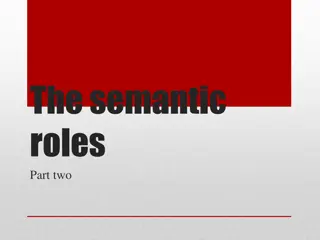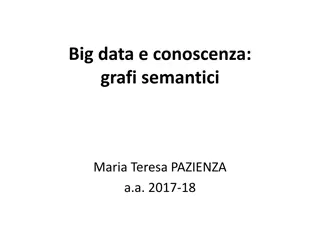Understanding Indexing: Key Concepts and Methods
Indexing plays a crucial role in organizing and retrieving information efficiently. It simplifies data, enhances accuracy, and enables quick access. This comprehensive guide explores the concept of indexing, different methods like pre-coordinate and post-coordinate indexing, factors affecting indexi
1 views • 18 slides
Understanding Semasiology: The Study of Word Meaning
Semasiology is a branch of linguistics focused on the meaning of words. It delves into various aspects of lexical meaning, semantic development, polysemy, and semantic structure. Through exploring types of word meanings and semantic changes, semasiology helps us comprehend the intricate nuances of l
4 views • 19 slides
Exploring the impact of automated indexing on completeness of MeSH terms
This study delves into the effects of automated indexing on the thoroughness of MeSH terms. It addresses the novelty of automated indexing, its implications for teaching, questions raised by students, observed missing index terms, and the significance of MeSH in practice. The explanation of how auto
4 views • 33 slides
Understanding Semantic Memory Models in Cognitive Psychology
Explore the structure and processes of semantic memory through traditional and neural network views. Delve into symbolic and network models, such as Collins & Quillian's 1970 model, which organize concepts as nodes and links, depicting relationships between concepts within semantic memory representa
1 views • 78 slides
Understanding Semantic Roles in Linguistics
Semantic roles, also known as theta roles, play a crucial part in understanding the relationships between participants and verbs in a sentence. They include agents, experiencers, causers, positioners, subject complements, and objects. Agents are typically the doers of actions, experiencers receive e
1 views • 18 slides
Understanding Semantic Roles in Sentence Structure
Semanticists analyze sentences based on semantic structure rather than traditional syntactic terms like subject and object. Instead, they use semantic terms such as Agent, External causer, Instrument, Affected, Recipient, and Locative. These terms help describe how people and things participate in r
1 views • 26 slides
Semantic Analysis of Clinical Narratives Using Complex Knowledge Graphs
Need for improved semantic analysis of clinical narratives for information retrieval and decision support is addressed through the use of complex knowledge graphs. These graphs capture axiomatic descriptions of generalizable truths about entities in the medical domain, providing a language-independe
0 views • 8 slides
Efficient Office Document Management Practices
Explore the key aspects of office document management, including filing and indexing systems, classification of records, steps in the record cycle, and the functions of filing and indexing. Learn how to organize, store, retrieve, and dispose of documents effectively to ensure operational efficiency.
1 views • 26 slides
Introduction to Information Retrieval: Compression Techniques and Index Optimization
Exploring concepts from information retrieval, this content delves into index compression methods such as blocked sort-based indexing and single-pass in-memory indexing. It discusses the importance of compression for inverted indexes to optimize memory usage and decrease disk space requirements, ult
0 views • 50 slides
Understanding Semantic Properties in Lexical Semantics
Explore the concept of semantic properties in lexical semantics through examples involving word meanings and relationships. Learn how semantic properties form the basic building blocks of language construction, sharing common attributes among words while also showing contrastive distinctions. Dive i
0 views • 17 slides
Evolution of Semantic Field Theory in Linguistics
The theory of semantic fields, also known as field-theory, originated in the 1920s and 1930s with German and Swiss scholars. J. Trier and L. Weisgerber further developed this theory post World War II, associating it with the Language and Society movement. Trier's approach focused on comparing the st
0 views • 20 slides
Understanding the Importance of Semantic HTML Tags
In this lecture, we delve into the significance of semantic HTML tags in structuring web content. We explore when to use
2 views • 9 slides
Exploring Semantic Web Technologies: RDFa, GRDDL, and POWDER
Delve into the depths of Semantic Web technologies with a focus on RDFa, GRDDL, and POWDER through the guidance of Dr. Nicholas Gibbins. Learn about embedding Semantic Web data, republishing embedded data, and the usage of GRDDL for XML transformations.
13 views • 38 slides
Advanced Tools for Text Indexing and Searching in SQL and Lucene
Explore advanced techniques for text indexing and searching using SQL statements like CREATE INDEX and FULLTEXT INDEX, along with insights into popular search engines such as Lucene, Sphinx, and Thinking Sphinx. Dive into the comparison between Lucene and Sphinx, and discover how tools like Sphinx S
0 views • 13 slides
Understanding Semantic Properties of Verbs in English Language
Explore the semantic properties of English verbs through various examples and classifications. Discover how verbs like hit, kiss, and touch share common properties, while verbs like make, create, imagine, and build belong to different classes based on their semantic relationships. Delve into the gra
0 views • 17 slides
Efficient Spatial Indexing Techniques for Range Queries
Explore spatial indexing methods such as grid file, kd-tree, and quadtrees for efficient range query processing. Learn how these methods partition space, handle multidimensional points, and optimize disk access. Discover the implementation details and search strategies for exact match and range quer
1 views • 56 slides
Efficient Billion-Scale Label-Constrained Reachability Queries
Graph data sets are prevalent in various domains like social networks and biological networks. Label-Constrained Reachability (LCR) queries aim to determine if a vertex can reach another vertex through specific labeled edges. Existing works utilize exhaustive search or graph indexing techniques, but
0 views • 13 slides
Semantic Web Technologies and Knowledge Representation Overview
Semantic Web technologies such as RDF, RDFS, OWL, and SPARQL form the basis of a web of data designed for machine understanding. Knowledge representation languages play a crucial role in AI, with Semantic Web languages like OWL leading the current generation. Contrasting database and knowledge base
0 views • 50 slides
Dynamic Semantic Parser Approach for Sequential Question Answering
Using a Dynamic Semantic Parser approach, the research focuses on Sequential Question Answering (SQA) by structuring queries based on semantic parses of tables as single-table databases. The goal is to generate structured queries for questions by defining formal query languages and actions for trans
0 views • 23 slides
Understanding Semantic Effects in Verbal Short-term Memory
Investigating the impact of semantic knowledge and similarity on verbal short-term memory, this study delves into how imageability of words influences recall. Key findings highlight the influence of semantic relatedness and the imageability effect on memory retention, shedding light on the mechanism
0 views • 47 slides
Unveiling Polarity with Polarity-Inducing Latent Semantic Analysis
Polarity-Inducing Latent Semantic Analysis (PILSA) introduces a novel vector space model that distinguishes antonyms from synonyms. By encoding polarity information, synonyms cluster closely while antonyms are positioned at opposite ends of a unit sphere. Existing models struggle with finer distinct
1 views • 29 slides
Multimodal Semantic Indexing for Image Retrieval at IIIT Hyderabad
This research delves into multimodal semantic indexing methods for image retrieval, focusing on extending Latent Semantic Indexing (LSI) and probabilistic LSI to a multi-modal setting. Contributions include the refinement of graph models and partitioning algorithms to enhance image retrieval from tr
1 views • 28 slides
Understanding String Indexing and Slicing in Python
Python strings are sequences of characters that can be accessed using indexing and slicing. Indexing allows you to access individual characters in a string using numerical positions, starting from 0. Slicing enables you to extract a portion of a string by specifying a range of indices. Understanding
0 views • 26 slides
Semantic Data Model of Electronic Invoicing Core Elements
Presentation by Fred van Blommestein on the EN16931-1 semantic data model of core elements in electronic invoicing, covering invoice processes, core invoice design, semantic model details, business rules, and invoicing principles. The model includes 160 elements in 33 groups, with mandatory elements
0 views • 13 slides
Mastering Array Selection and Indexing in Data Processing
Unlock the power of array selection and indexing techniques through a series of educational slides. Explore different methods for selecting elements from arrays and dive into various indexing strategies, suitable for beginners and experienced professionals alike. Gain insights into cell structures,
1 views • 70 slides
Revisiting Semantic Feature Analysis: A Classic Therapy Technique
Aphasia often involves semantic breakdown, and Semantic Feature Analysis (SFA) is a foundational technique for various treatments addressing semantic impairments. This presentation explores the effectiveness of SFA in improving naming, generalization to spontaneous speech, and treatment goals beyond
0 views • 16 slides
Understanding ISAM Indexes and Tree-Structured Indexing Techniques
This content delves into the concepts of ISAM (Indexed Sequential Access Method) indexes and tree-structured indexing techniques used in database management. It explores the differences between ISAM and B+ trees, the implementation of sparse and dense indexes, and the structure of ISAM tree indexes.
0 views • 12 slides
Integrated Reporting Workshop Wrap-Up and Next Steps
The workshop on integrated reporting held on 1st December 2022 focused on enhancing proposals, planning JBRC setup, data dictionary governance, semantic integration, and more. The roadmap for 2023 includes topics like data granularity, governance, and continuous work on semantic and syntactic layers
0 views • 4 slides
Semantic Relations Expressed by Prepositions in Modeling Study
Explore the study on modeling semantic relations expressed by prepositions conducted by Vivek Srikumar and Dan Roth from the University of Illinois, Urbana-Champaign. The research delves into prepositions triggering relations, ontology of preposition relations, examples of preposition relations, pre
0 views • 25 slides
Ensembling Diverse Approaches to Question Answering
Diverse types of question answering approaches include factoid querying, compositional querying of structured databases/knowledge graphs, reading comprehension, and visual question answering. Limitations of factoid question answering are also discussed, highlighting the need for specific queries and
0 views • 28 slides
Understanding Partitives and Verbal Indexing in Language
Partitives are grammatical constructions used to encode true-partitive relations, involving quantifiers and restrictors. They can also express plain quantification. Verbs may vary in indexing within partitives. Pseudo-partitives and true partitives exemplify how partitive constructions work. This st
0 views • 31 slides
Annotating Semantic Issues in Translation for Students
This chapter delves into semantic issues in translation, aiming to assist students in annotating their translations from a semantic viewpoint. It emphasizes using semantic information to aid in translating data accurately while maintaining communicative effectiveness. The story discussed highlights
0 views • 19 slides
Semantic Classification of Prepositions in Bulgarian WordNet: A Comprehensive Overview
This presentation delves into the semantic classification of prepositions in the BulTreeBank WordNet, focusing on the incorporation of prepositions, closed-class words, and the benefits for neural model building in Bulgarian language processing. The motivation behind the study, challenges posed by p
0 views • 7 slides
Semantic Technologies for Data Management and Knowledge Extraction
An exploration of how semantic technologies facilitate data management, knowledge extraction, and understanding in the realm of big data. Topics covered include semantic graphs, content information extraction, and the impact of semantic models on enhancing data value and relationships. The importanc
0 views • 38 slides
Exploring NoSQL Database Scalability Using Indexing Techniques
Dive into the world of NoSQL database scalability by understanding how indexing enables richer queries and how local indexing impacts partitioning, updates, and lookups across distributed databases.
0 views • 59 slides
Requirements for Semantic Biobanks and Global Biobank Data Retrieval
Explore the critical aspects of semantic interoperability in biobanking, highlighting the need for formal ontologies, comprehensive annotations, and model of meaning data. The (Generalized) Biomedical Retrieval Scenario underscores the importance of effective resource retrieval based on content-base
0 views • 16 slides
Flexible Spatio-temporal Indexing Scheme for Large Scale GPS Tracks Retrieval
This research paper discusses a novel spatio-temporal indexing scheme optimized for managing large-scale GPS data. The study introduces a stochastic process model to simulate user behavior in uploading GPS tracks, leading to a more efficient indexing scheme with smaller size, minimal update efforts,
0 views • 24 slides
Exploring Binary Representation and Semantic Approaches in Data and Programs
Delve into the fascinating realm of binary representation and semantic approaches in data and programs through a series of discussions and examples. Topics include encoding/decoding relevance, tamper-proof bytecode formats, incorporating semantic info for compact encodings, and playing guess-who gam
0 views • 21 slides
Advances in Neural Semantic Parsing
Delve into the realm of neural semantic parsing with a focus on data recombination techniques, traditional parsers, and the shift towards domain-general models. Explore the application of sequence-to-sequence models and attention-based neural frameworks in semantic parsing tasks. Discover the evolvi
0 views • 67 slides
Understanding RDF Schema: A Deep Dive into Semantic Web
In this detailed exploration of RDF Schema, Dr. Nicholas Gibbins covers topics such as defining classes and properties, subclass relationships, semantic implications, reflexive properties, type distribution, and property definitions in RDF. Learn about the essential aspects of RDF Schema and its rol
0 views • 19 slides







































